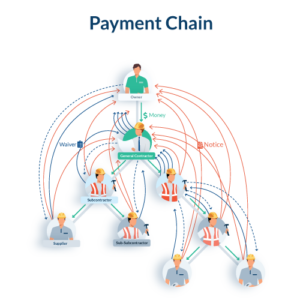
Construction payment is unique. The construction industry has several parties to each transaction which makes it complicated and sometimes, not very transparent. These parties can include the general contractor, subcontractors, suppliers, and laborers.
If you’re reading this, you probably understand all too well that laborers are often the first to go unpaid when there are payment problems on the job.
Let’s take a look at why that is, what tools a laborer can utilize when payment is not made, and how to use those tools.
Why Do Construction Laborers Go Unpaid?
First, let’s settle what we’re calling a “laborer.” After all, pretty much every trade performs some type of labor when working on a job.
For the purposes of this post, we’re referring to those individuals who provide labor as a result of their employment by a contractor, subcontractor, etc. We’re talking about the actual workers who have their (steel toe) boots on the ground at the job site itself. Last but not least, we’re talking about wage laborers — folks that are paid an hourly wage for their work (as opposed to a salaried employee).
Project payments in the construction industry are dominated by the unique system that all payments must operate within. Here at Levelset, we call this system the payment chain.
In short, all project payments start at the very top of the payment chain in the upper tiers and must work their way down the chain to all of the downstream project participants. Typically, the payments must pass through each level or “tier” of the chain — and through all of the participants that occupy that level — as the money flows down.
And here’s the rub: the further you get down in the payment chain, the more likely it becomes that you could experience payment problems, be they non-payment issues or abuses in the payment process.
What usually happens is, if there is an event of non-payment or abuse of the payment process at any one point along the chain, this event would have the potential to cause a domino effect that could affect everyone downstream on the project.
But here’s the thing about construction laborers: a construction laborer could occupy any tier of the construction project.
Generally, Construction Wage Laborers Have Their Own Lien Rights
Generally speaking, construction laborers do have their own lien rights on a construction job. This includes contractor day laborers as well as laborers that are employees of one of the parties (the general contractor, a subcontractor, or a sub-sub) on the job.
The presence of lien rights for laborers is precisely why GCs or subs are sometimes required to provide an affidavit stating that they have no outstanding payroll obligations on a job. If they did still owe some money to their employees, then those individual employees could potentially each have a lien right on the project. And if those employees continued to go unpaid on the job, then there would be nothing stopping them from filing a mechanics lien (provided, of course, that they had met all of the requirements needed to be able to file a valid mechanics lien).
Wage Laborers Typically Do Not Have to Send a Preliminary Notice
In the vast majority of states, a construction company working on a project is required to send a preliminary notice in order to secure their right to file a mechanics lien. This preliminary notice requirement is a common source of problems in the mechanics lien process — if a notice is required and it’s not sent, it can result in an invalid mechanics lien.
However, individual wage laborers generally do not have this same preliminary notice requirement. This is a huge burden off the shoulders of wage laborers — if they encounter a payment issue on a project that they can’t seem to solve on their own, they can file a mechanics lien without having to worry about whether they sent a notice way back at the beginning of their employment. But as we’ll see in the next section, sometimes the credible threat of a mechanics lien can work just as well as a mechanics lien itself.
Threatening to Lien Could Get You Paid (Without Having to Actually File a Lien)
Filing a lien is an option for recovery (and a strong one, to boot). But that does not mean its the only option, or even the right option. Before resorting to a lien filing, it’s usually worth threatening to file that lien beforehand. Mechanics liens are a powerful tool, and there are a number of ways they compel payment (we came up with 17 ways in this article). Because there’s so much power in a lien filing, though, the mere threat of lien is typically enough to get the payment talks rolling.
Plus, if the threat doesn’t work, a claimant can always go through with it. Still, merely calling someone up saying “Pay me or else!” might not be the best way to go about things. Rather, we’ve found that a Notice of Intent to Lien will carry a lot of weight. You can learn more about the document at the link underneath this section, but essentially, it serves as a formal warning that nonpayment (or slow payment) won’t be taken lightly.
Finally, laborers are in a unique position when it comes to threatening to file a lien. For one, sending a Notice of Intent to Lien to the GC and the property owner can be effective just like it comes from any other claimant. When a contractor or owner receives a Notice of Intent to Lien, they understand that there’s a payment problem on the project, and they know that ignoring the issue won’t make it go away.
But a laborer could also threaten their own company with a potential lien filing. Now, that doesn’t mean a laborer can file a lien against their company – lien filings encumber the property, not any person or company. No, if the laborer’s company knows one of their laborers might file a lien on the job, that could light a fire under their rear-end to make payment to the laborer.
One lien filing can disrupt an entire project, and a company can catch a lot of heat from the owner and the GC if that company’s laborer files a lien.
Filing a Lien: the Nuclear Option
Mechanics liens were uniquely designed for the construction industry to ensure protection for almost all of the parties that work on a typical construction project, including laborers. Mechanics liens are a statutorily given remedy (that means that mechanics liens are legal rights – they are actually laws) that function as a powerful collection tool for payment in the construction industry nationwide!
Since a mechanics lien is so powerful, they are also strictly regulated by several requirements that all must be met by those that intend to file a lien. Those requirements include deadlines, form requirements, and potential notice requirements.
All that being said, you should try to do everything you can to get paid without having to file a lien. In order to do this, you should be proactive and send notices which promote transparency and attempt to resolve disputes before filing your lien. But in the end, if all of your good-faith attempts to resolve your non-payment issue end up going nowhere, then it may be comforting to know that mechanics lien protections do exist.
Free Legal Resource
The mechanics lien process is confusing and complicated. There are a number of different factors that affect which lien rights requirements exist in a given state, or even on a given project. Thankfully, Levelset is here to help! If you have any construction payment questions at all – no matter where you work, what you do, or who you are – you can visit our Construction Legal Center to have your questions answered by our licensed, construction attorneys, all for free. This isn’t a joke, and that’s not a typo. Our attorneys are standing by, so go ahead and hit us with your best (question) shot!

